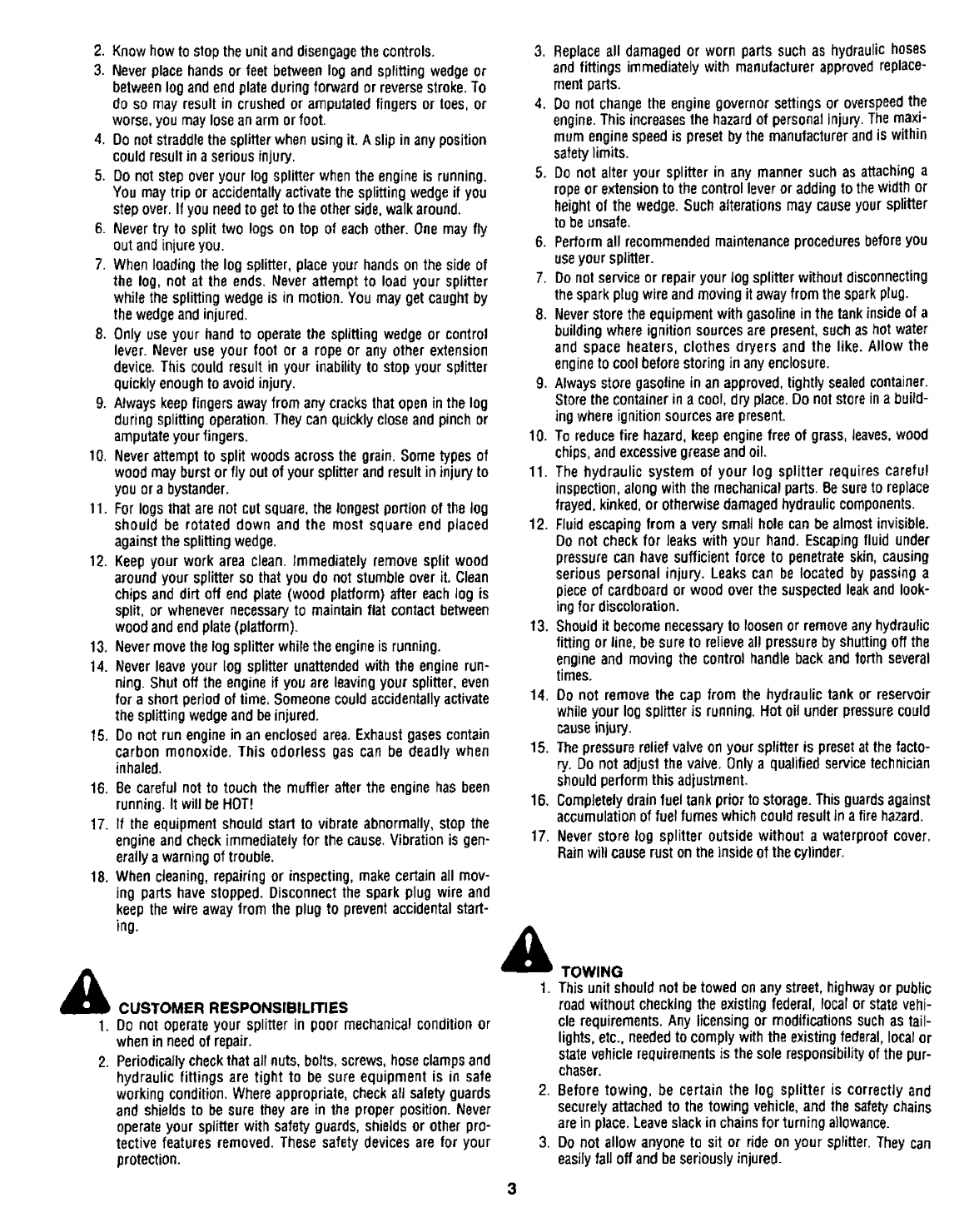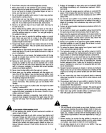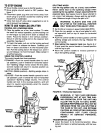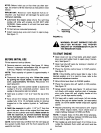
2. Know how to stop the unitand disengagethe controls.
3. Never placehandsor feet between log and splitting wedge or
between log and end plateduring forward or reversestroke. To
do so may result in crushedor amputated fingers or toes, or
worse, you may losean arm orfoot.
4. Do not straddlethe splitter when using it. A slip inany position
couldresultin aserious injur),.
5. Do not step over your log splitter when the engineis running.
You may trip or accidentallyactivate the splitting wedgeif you
step over. If you needto get to the other side, walkaround.
6. Never try to split two logs on top of each other. One may fly
out andinjure you.
7. When loading the log splitter, place your hands on the side of
the log, not at the ends. Never attempt to load your splitter
while the splitting wedgeis in motion. You mayget caught by
the wedgeand injured.
8. Only use your hand to operate the splitting wedge or control
lever. Never use your foot or a rope or any other extension
device, Thiscould result in your inabilityto stop your splitter
quickly enoughtoavoidinjury,
9. Always keepfingers awayfrom any cracksthatopenin the log
during splitting operation.They canquickly closeand pinchor
amputateyour fingers,
10, Neverattemptto splitwoods acrossthe grain. Some types of
woodmay burst or fly out ofyour splitterand resultininjuryto
you or abystander,
11. Forlogsthat are not cut square,the longest portionof the tog
should be rotated down and the most square end placed
againstthe splittingwedge,
12, Keepyour work area clean. Immediately remove split wood
around your splitterso thatyou do not stumbleoverit, Clean
chipsand dirt off end plate(wood platform) after eachtog is
split, or whenever necessaryto maintain flat contact between
wood and endplate(platform).
13. Nevermovethe log splitter whilethe engineis running.
14. Never leave your Iog splitter unattendedwith the enginerun-
ning. Shut off the engineif you are leaving your splitter, even
for a short period of time. Someone couldaccidentally activate
the splitting wedgeand beinjured.
15. Do not run enginein an enclosed area. Exhaust gasescontain
carbon monoxide. This odorless gas can be deadly when
inhaled.
16. Be carefulnot to touch the muffler after the engine has been
running.It will beHOT!
17. If the equipment should start to vibrate abnormally, stop the
engineand check immediately for the cause, Vibration is gen-
erally awarning of trouble.
18. When cleaning, repairing or inspecting,make certainall mov-
ing parts have stopped. Disconnect the spark plug wire and
keepthe wire away from the plug to prevent accidental start-
ing.
.
CUSTOMER RESPONSIBILITIES
Donotoperateyour splitterin poormechanicalconditionor
wheninneedofrepair.
Periodicallycheckthatallnuts,bolts,screws,hoseclampsand
hydraulicfittings aretight to be sureequipmentis in safe
workingcondition.Whereappropriate,checkall saletyguards
andshieldsto besuretheyareintheproperposition.Never
operateyoursplitterwithsafetyguards,shieldsor otherpro-
tectivefeaturesremoved.Thesesafetydevicesarefor your
protection.
3
3, Replace all damaged or worn parts such as hydraulic hoses
and fittings immediately with manufacturer approvedreplace-
ment parts.
4. Do not change the engine governor settingsor overspeed the
engine. This increases the hazardof personal injury.The maxi-
mum engine speed is preset bythe manufacturer andis within
safetylimits.
5. Do not alter your splitter in any manner such as attaching a
rope or extensionto the control lever oradding to thewidth or
height of the wedge.Such alterations may causeyour splitter
to beunsafe.
6. Perform all recommended maintenanceprocedures beforeyou
useyour splitter.
7. Donot serviceor repair your togsplitter without disconnecting
the spark plug wire and moving it away from the spark plug.
8. Neverstore the equipment with gasoline in the tank insideofa
building where ignition sources are present, such ashot water
and space heaters, clothes dryers and the like. Allow the
engineto cool before storing in any enclosure.
9. Alwaysstore gasoline in an approved, tightly sealedcontainer.
Store the containerin a cool, dry place. Do not store in abuild-
ing where ignition sources are present.
10. To reducefire hazard, keepengine free of grass, teaves,wood
chips,andexcessivegrease andoil.
11. The hydraulic system of your log splitter requires careful
inspection, along withthe mechanical parts.Besureto replace
frayed, kinked,or otherwise damagedhydraulic components.
12. Fluid escaping from a very small hole canbe almostinvisible.
Do not check for leaks with your hand. Escaping fluid under
pressure can have sufficient force to penetrate skin, causing
serious personal injury. Leaks can be located by passing a
pieceof cardboardor wood over the suspected leakand look-
ingfor discoloration.
13. Should it become necessaryto loosenor removeany hydraulic
fitting orline, be sure to relieveall pressure by shutting of/the
engine and moving the controlhandle back and forth several
times.
14. Do not removethe cap from the hydraulictank or reservoir
while your log splitter is running. Hot oilunder pressure could
causeinjury.
15. Thepressurerelief valve on your splitter is preset at the facto-
ry. Do not adjustthe valve, Onlya qualified service technician
should perform this adjustment.
16. Completelydrainfuel tankprior tostorage, Thisguardsagainst
accumulationof fuel fumes whichcouldresultin a fire hazard.
17. Never store log splitter outside without a waterproof cover.
Rainwiltcauserustonthe inside of thecylinder.
TOWING
1. Thisunitshouldnot be towed onanystreet, highwayor public
road without checking the existingfederal, focal or statevehi-
cle requirements. Any licensing or modifications such as tail-
lights, etc., neededto comply with the existingfederal, localor
state vehiclerequirementsisthe sole responsibility ofthe pur-
chaser.
2. Before towing, be certain the log splitter is correctly and
securelyattachedto the towingvehicle, andthe safetychains
arein place.Leaveslackin chainsfor turning allowance.
3. Do not allowanyone to sitor ride on your splitter. They can
easilyfalloff and be seriously injured.


















